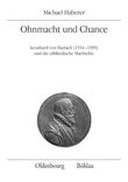Explore

Ausgangspunkt der Untersuchung ist das konfliktreiche Landtagsgeschehen im Sommer des Jahres 1579 in Wien. Der kaiserliche Ratgeber Leonhard von Harrach verhandelte mit den Köpfen des opponierenden protestantischen Adels, der gegen Kaiser Rudolf II. die Glaubensfreiheit für die landesherrlichen Städte und Märkte in Niederösterreich durchsetzen wollte. Die Analyse der Beziehungen Harrachs zu den Opponenten, sowie seines Handlungsspielraums als Mitglied der Regierung, Ratgeber und Mentor eines jungen, spanisch-katholisch orientierten Kaisers, höfischer Berufspolitiker, landsässiger Adliger, Autorität einer erbländischen Machtelite, Chef des Hauses Harrach und um Ausgleich bemühter Katholik ermöglicht, die Spezifik des Konflikts zu entwickeln. Die historiografische Basis dieser Handlungsfelder musste teils von Grund auf erarbeitet werden, da bspw. in der Geschichtsschreibung eine Machtelite aus landsässigen Adligen in der Habsburgermonarchie des 16. Jahrhunderts nicht existiert. Deren Existenz verändert das Verständnis von ständestaatlichem "Dualismus" hin zu einem komplexen dualistischen System, in dem eine "staatliche", gewinnorientierte Funktionselite aus dem landsässigen Niederadel der niederösterreichischen Länder im Herrschaftsapparat und in den Landständen dominiert. Adelsgeschlechter wie die Roggendorf, Jörger, Hoffmann, Windischgrätz oder Khevenhüller, die alle über ein verwandtschaftliches Netzwerk mit Harrach verbunden waren, gehörten zu den herausragenden Profiteuren der Staatsbildung und brachten gleichzeitig die bedeutendsten Führer der protestantischen Opposition in Wien und Graz hervor. Obwohl die Konfliktkultur des dualistischen Systems der Konfessionalisierung nicht gewachsen war, erwies sich die Kooperation der Dynastie mit den hoforientierten Landleuten der Erbländer im 16. Jahrhundert als staatsgeschichtliches Erfolgsmodell, das in der österreichisch-böhmischen Aristokratie der Dyarchie in größerem Stil fortgesetzt wurde. Die Stärken dieser Machtelite ermöglichten Harrach und dem Oppositionsführer Jörger nach 1580 eine Art Krisenmanagement. Allerdings litt unter der zunehmenden Polarisierung die Irenik des Kaiserberaters Harrach. Die Aufnahme in den spanisch-katholischen habsburgischen Hausorden vom Goldenen Vlies gab den entscheidenden Impuls, um zusammen mit Statthalter Erzherzog Ernst die Federführung in einer moderaten, aber zwangsweisen Rekatholisierung der niederösterreichischen Städte und Märkte, die vom Passauer Offizial Melchior Khlesl organisiert wurde, zu übernehmen.
This book is included in DOAB.
Why read this book? Have your say.
You must be logged in to comment.
Rights Information
Are you the author or publisher of this work? If so, you can claim it as yours by registering as an Unglue.it rights holder.Downloads
- 152 - pdf (CC BY-NC-ND) at OAPEN Library.
- 111 - pdf (CC BY-NC-ND) at OAPEN Library.
- 180 - pdf (CC BY-NC-ND) at OAPEN Library.
Keywords
- Aristocratic Power Elite
- Austria
- catholic confessionalization
- Court and Country
- Geheimrat
- Habsburg
- History
- Humanities
- Leonhard von Harrach (1514 - 1590)
- Noble Estates
- Protestantismus
- Römisch-katholische Kirche
- Rudolf II. (HRR)
- thema EDItEUR::N History and Archaeology::NH History
- Wien
Links
DOI: 10.26530/oapen_437182Editions

